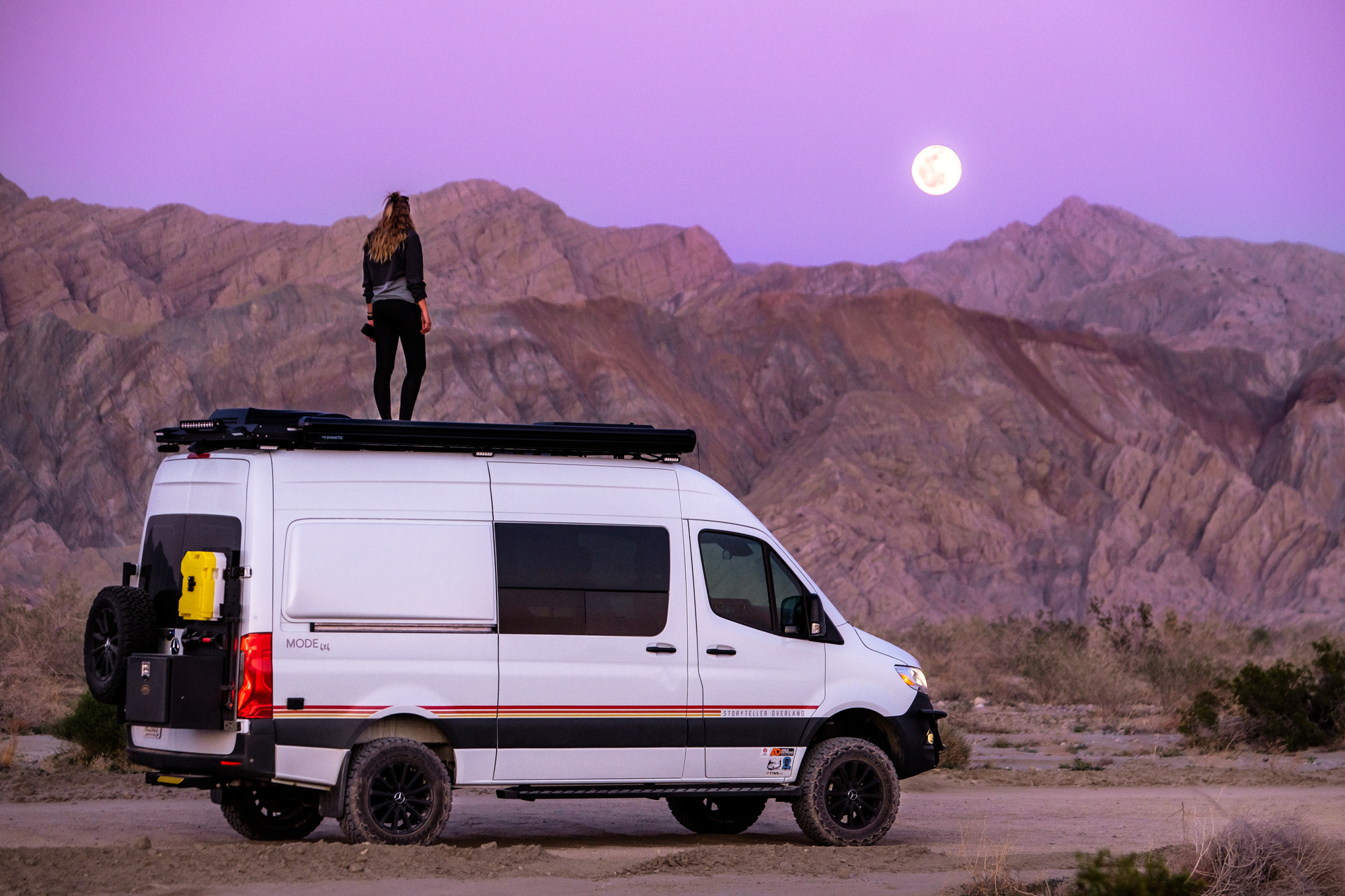Each year, hundreds of thousands of RVs are sold throughout the United States. The materials they’re built from are often cheap, and their entry prices are as low as their ground clearance, but for the average buyer looking to hit the road for a few weeks a year, they’re just good enough. However, a growing number of consumers want something more, something better. They want higher-quality materials, improved space efficiency, room for their outdoor gear, and a little off-road capability to take them further than other RVs can go. That used to mean pursuing custom solutions from a variety of small van shops. But more recently, some big manufacturers have stepped up to the plate—the latest of those is Storyteller Overland with the Mode 4×4.
For our conclusions, skip to the bottom. For the details, read on.
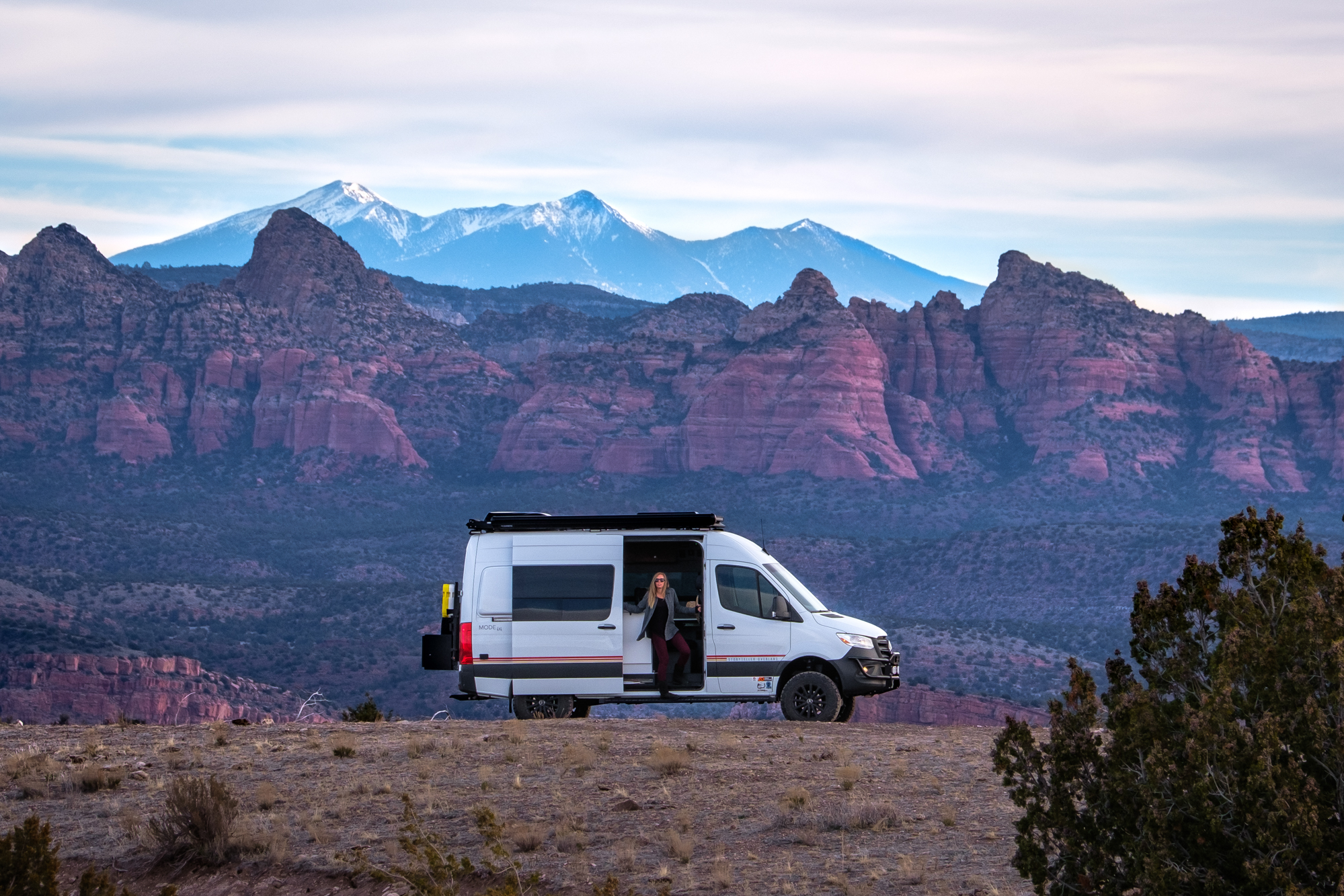
What Makes the Mode 4×4 Different
Walking up to the Mode at Overland Expo West last year, I was immediately struck by the notion that it wasn’t your everyday RV. The factory tires are all-terrains from BFGoodrich, the roof rack is from Front Runner, and it is only available in four-wheel drive. There are no side skirts or lower fascias bolted on, no pipes or tanks hanging off the belly, and no ridiculous graphics or badging thrown on its sides to make it “look adventurous.” It doesn’t need to look adventurous, because it is adventurous. It is clean and capable, an authentic adventure van. Yet, it was the interior that solidified my appreciation for the Storyteller. Unlike the cheap RVs I have come to know, the materials in the Mode are solid, the colors timeless, and the layout open and airy. There is seating for four, an innovative shower/bathroom combo, and a rugged garage for hauling gear that is tall enough for mountain bikes. I had to double-check that I had walked into the right van because it was so much better than I had expected for an “RV” sold through dealerships nationwide. I wasn’t sure how it would hold up to daily use on and off road, but I certainly intended to find out.
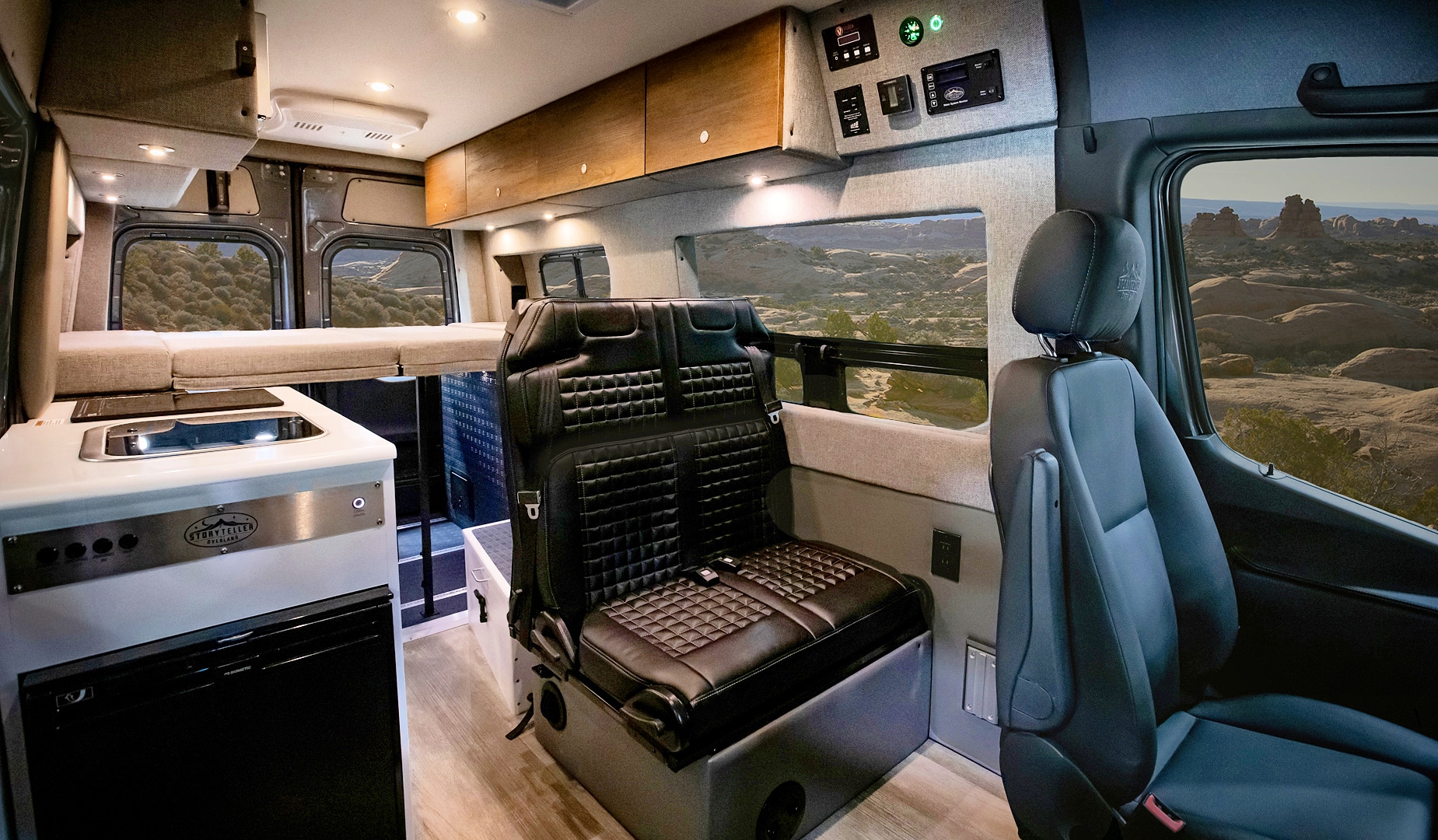
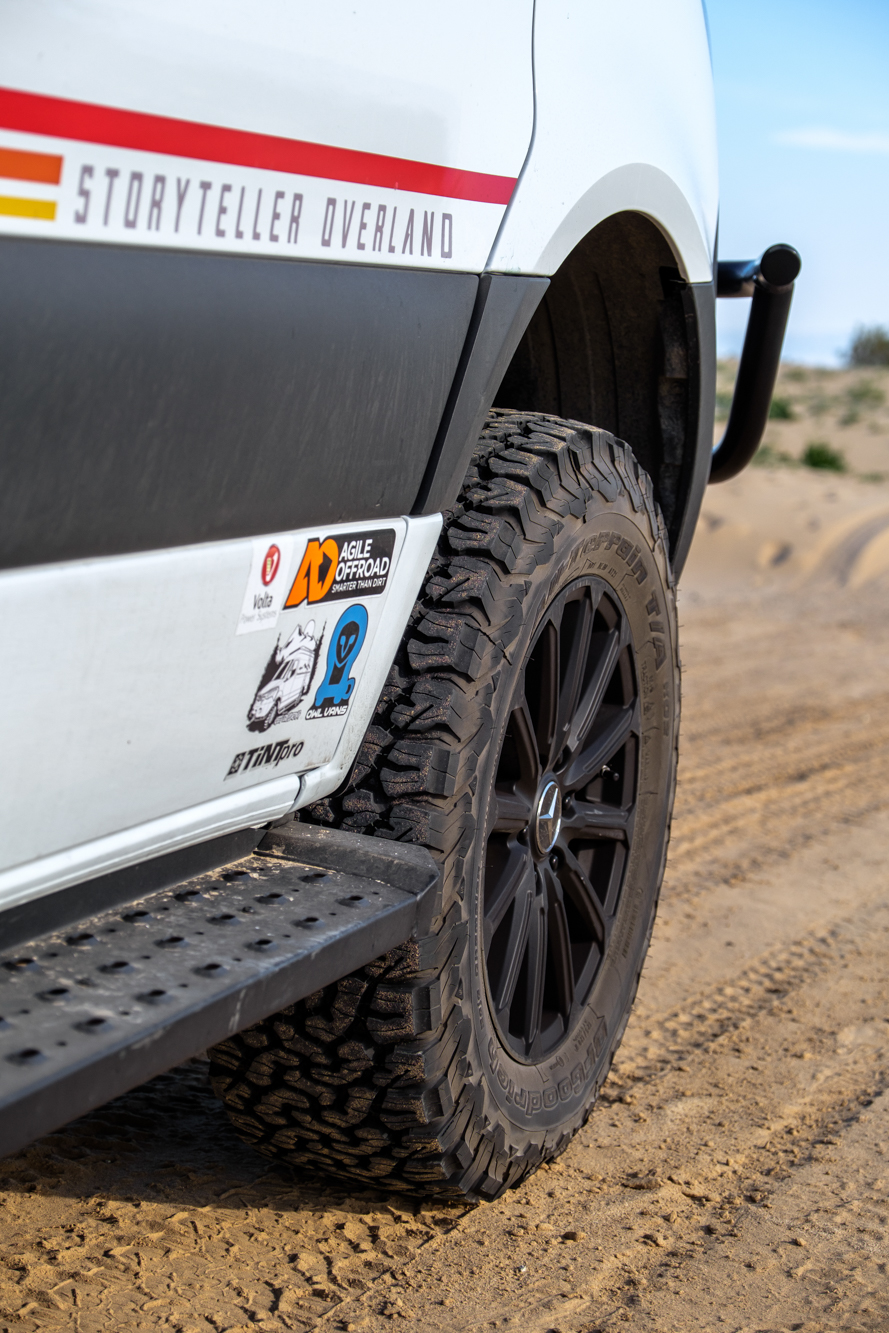
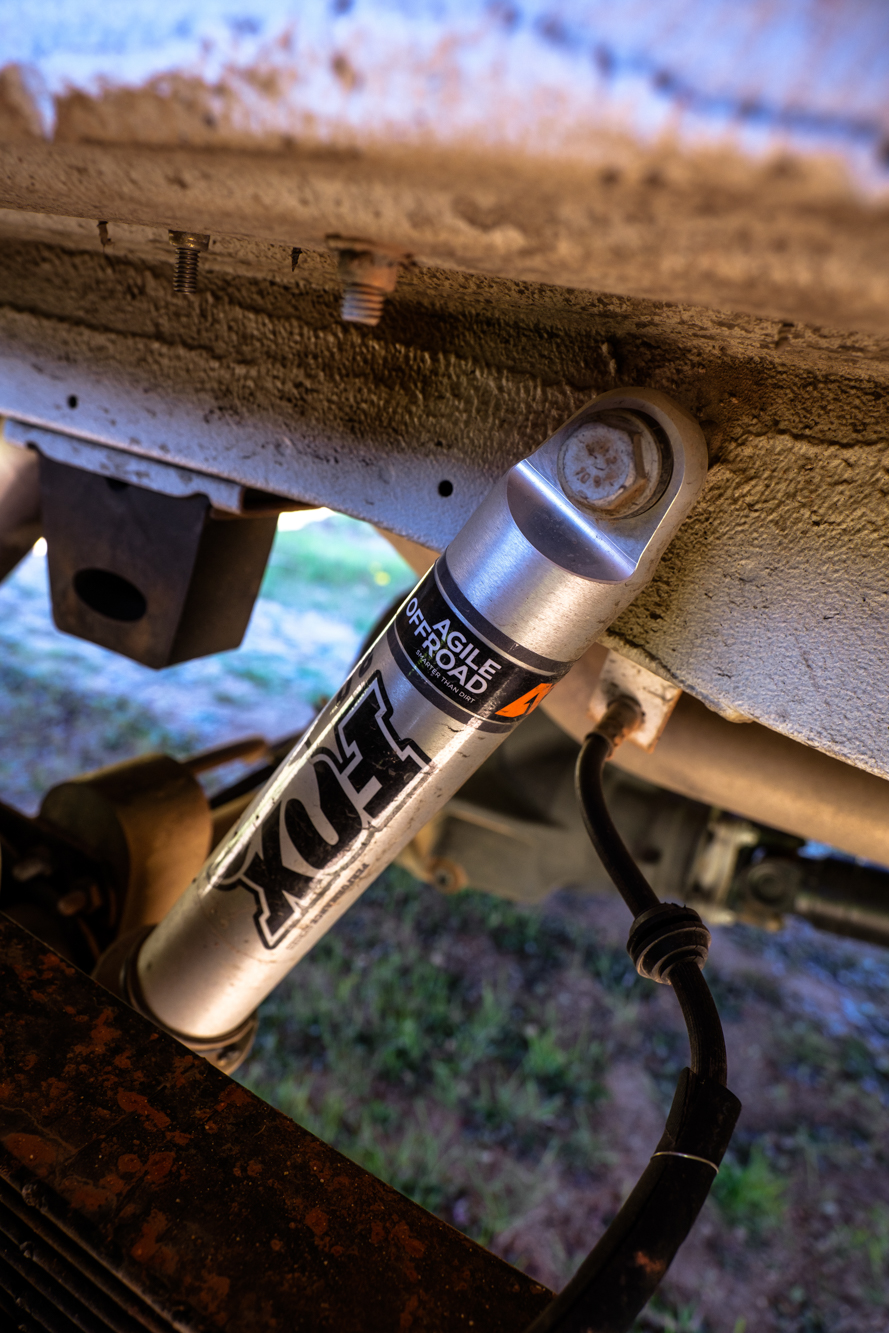
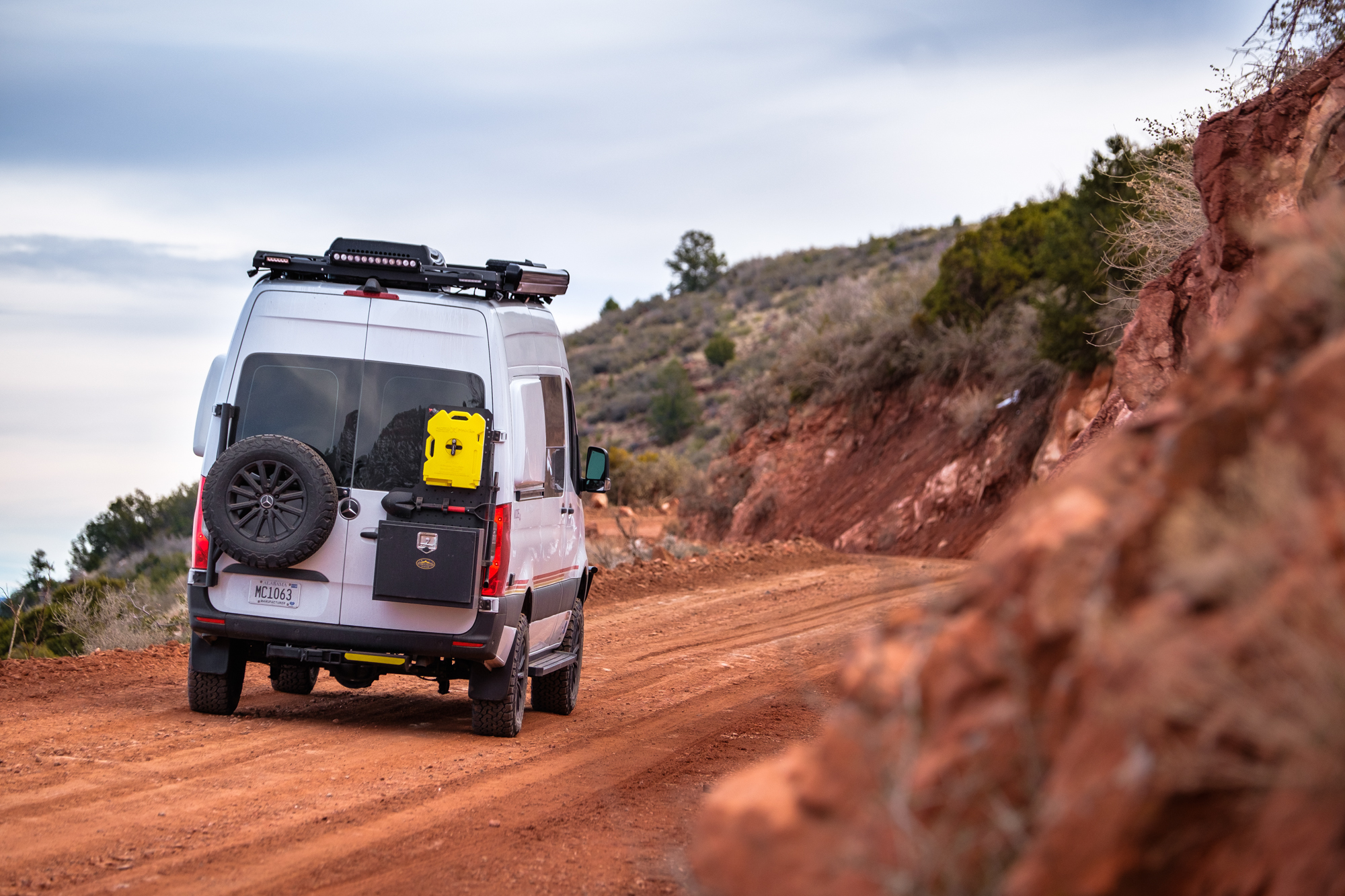
Testing Procedures
I have found that the best way to understand the strengths and weaknesses of a platform is to utilize them in the field, so to test the Storyteller Mode, we did just that. We moved into the van for nearly two weeks and drove it from California to Arizona and back again across every type of terrain that the landscape had to offer. We used each system and pushed its limits whenever possible. Below, you’ll find out what we learned.
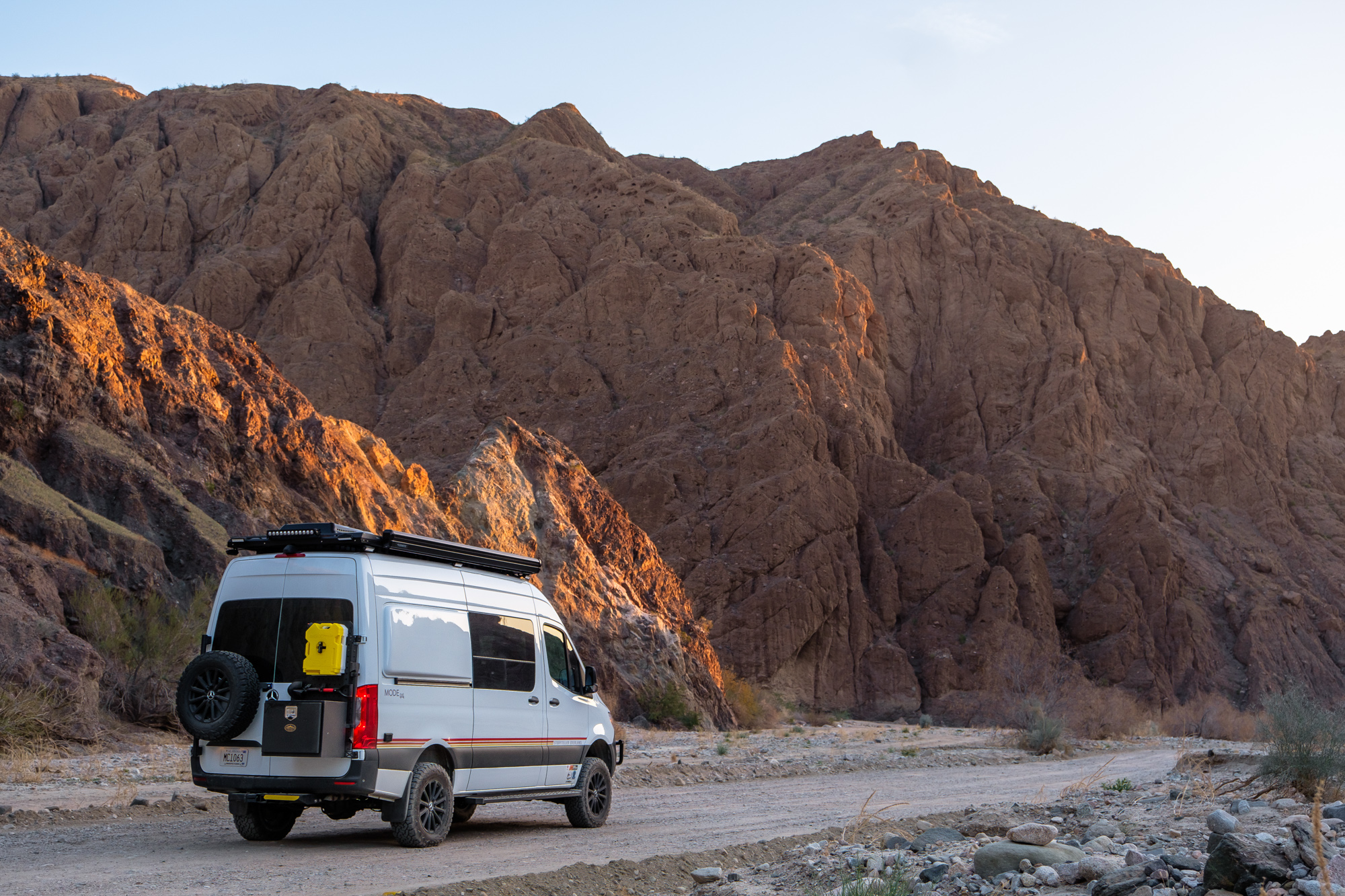
Off-Road Performance
– No lower RV fascias
– Clean undercarriage
– Good tires
– Surprisingly capable
It seems like everyone wants to know about the off-road capability of the Sprinter, so let’s just get that out of the way now. While companies are managing to stuff 35-inch tires under these vans, it’s important to know that they are not meant to be trail rigs. They are travel vehicles, designed with that purpose in mind, not rock crawling. Still, on 99 percent of what we would need to drive on as overlanders, a Mode 4×4 will tackle with ease. That’s because Storyteller understands what’s important on an off-road van. They kept the undercarriage clean and free of low hanging pipes and tanks, the approach and departure angles weren’t ruined with cheesy bolt-on fascias, and they installed proper all-terrain tires instead of thin-walled all-season ones. Thanks to these wise decisions, soft sand, deep snow, mud, and yes, even some technical terrain are all within the capabilities of the Mode 4×4.
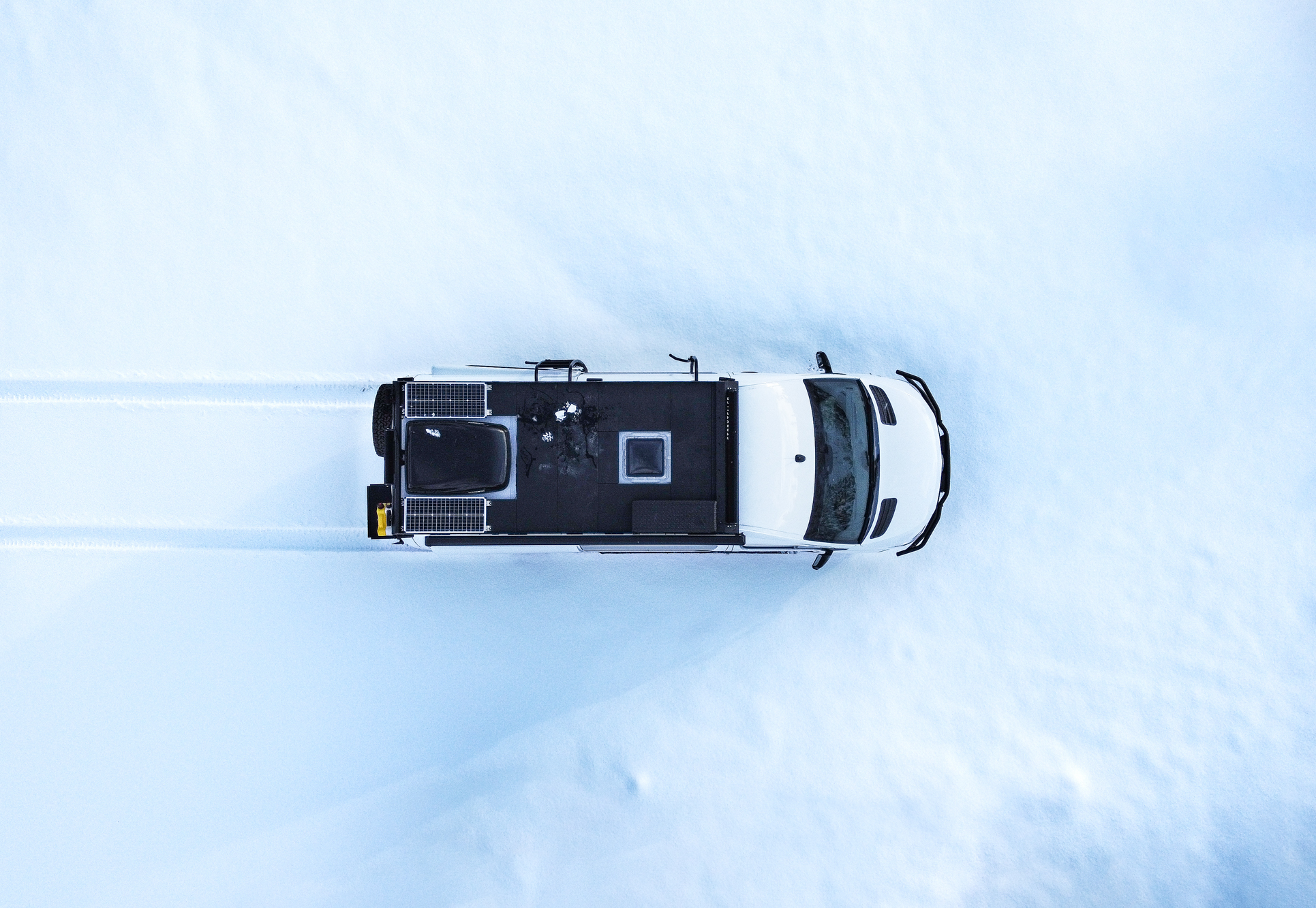
To be honest, once you accept that your goal isn’t to be the most capable vehicle on the trail, wheeling the Mode 4×4 becomes an absolute blast. Unlike driving a Wrangler, ZR2, Land Cruiser, or Discovery where you have to seek out a select few trails to challenge the vehicle, the Mode can make lighter and more easily accessible trails a fun challenge. It’s like rewinding the clock to the first time you went out in your 4×4, and having to learn the ropes all over again. As someone who has gotten used to the point-and shoot-method of off-roading on 37-inch tires, I couldn’t help but smile.
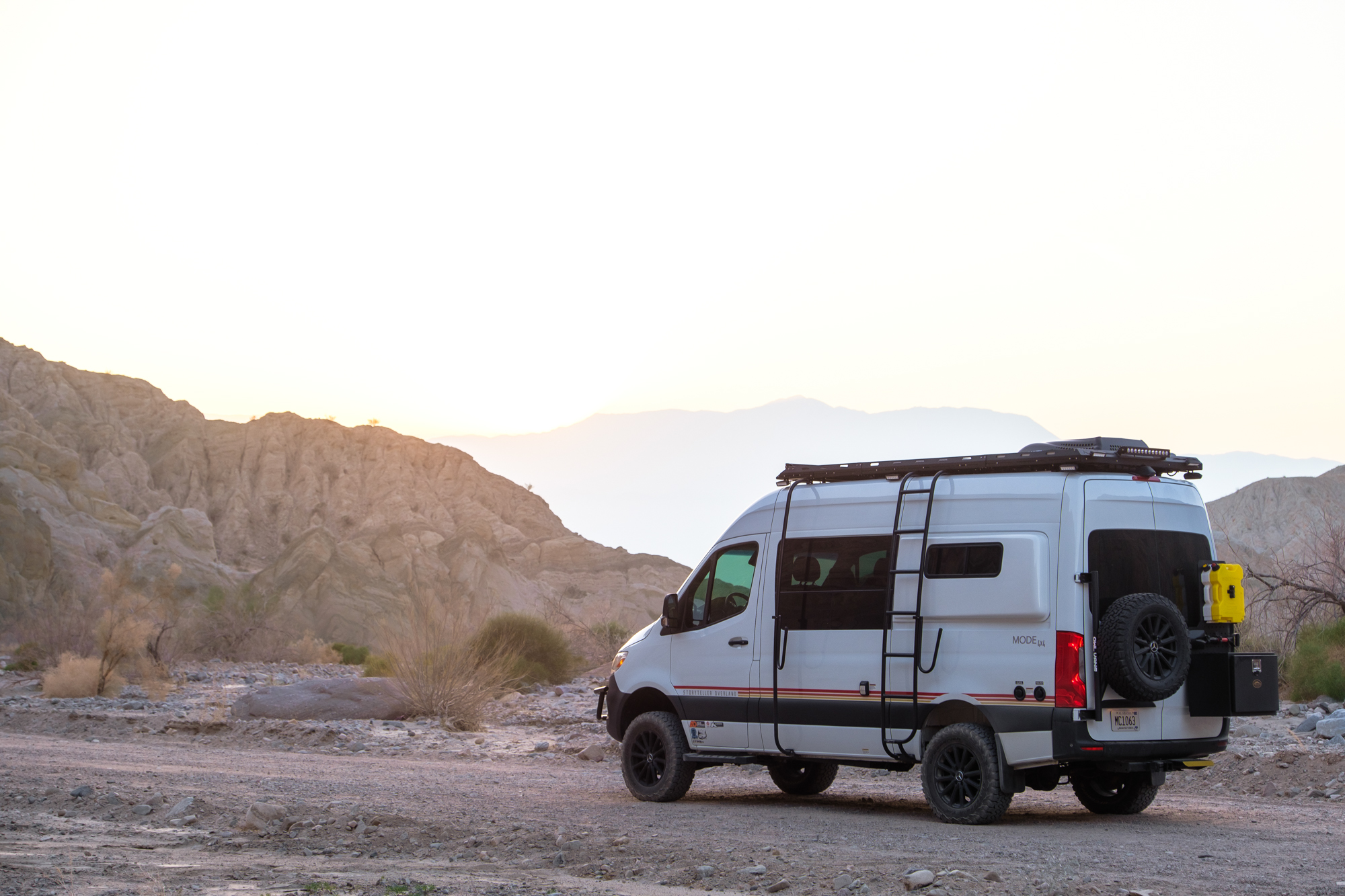
Power, Water, and Heat
– 230 Ah lithium battery @ 58 volts (1000+ Ah equivalent at 12 volts)
– 3,600-watt inverter
– 21-gallon fresh water tank
– 24-gallon gray water tank
– Diesel hot water/cabin heat
Storyteller lists the Mode as having a 12 kilowatt-hour (kWh) battery managed by a Volta power system, but it’s actually 13.6 kilowatt-hours or about 230 amp hours at 58 volts. The 12kWh is usable energy, which gives the van just over 200 amp hours for whatever you want before the safety measures kick in. With a 3,600-watt inverter, we were able to run the microwave, induction cooktop, charge laptops, and run the lights all at the same time without an issue. Even with this sort of aggressive power consumption, we only drained the battery to around 50 percent, which recharged quickly, thanks to the high output auxiliary alternator and factory solar. Speaking of solar, the Mode 4×4 comes prewired for up to 600 watts.
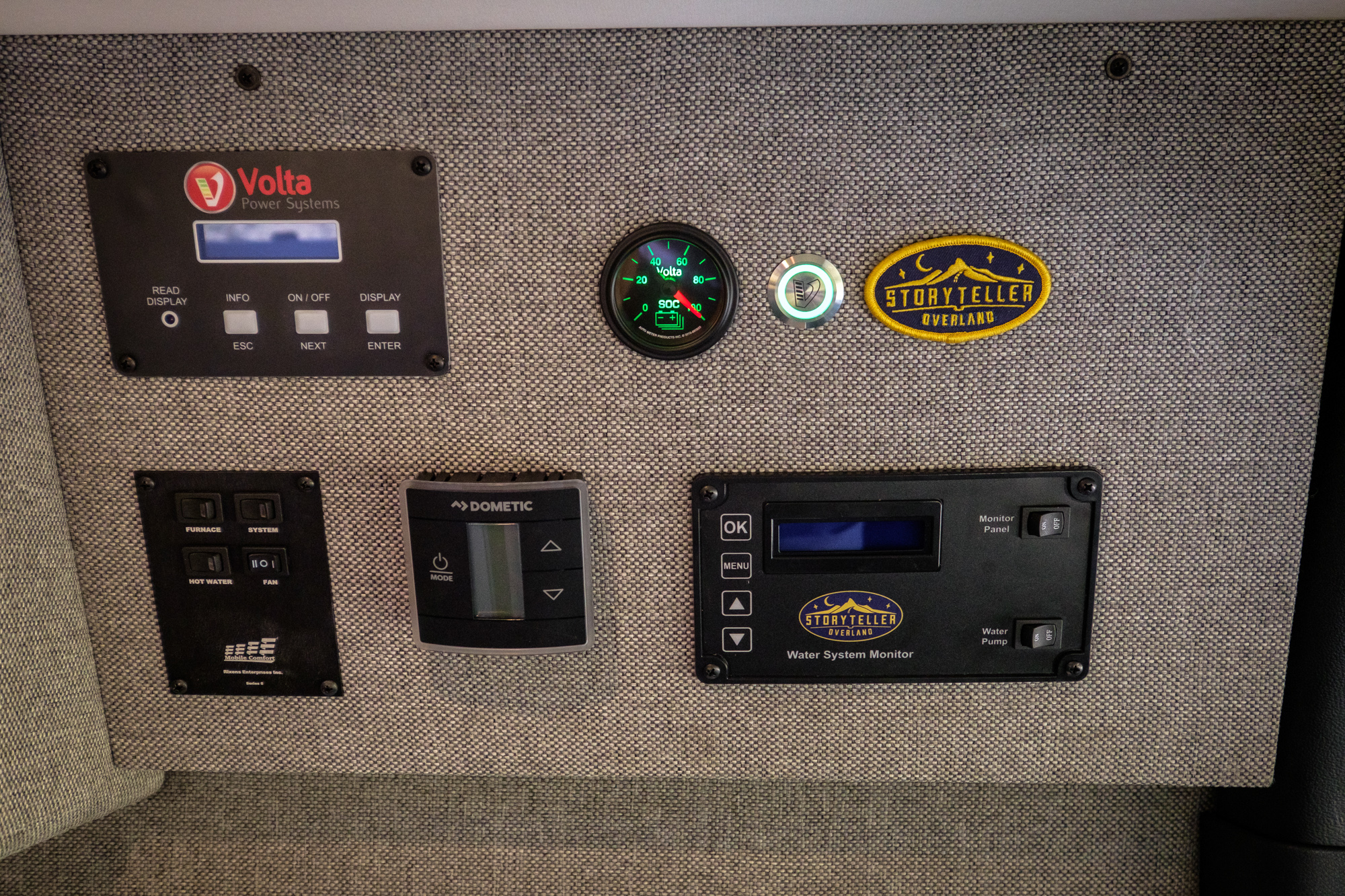
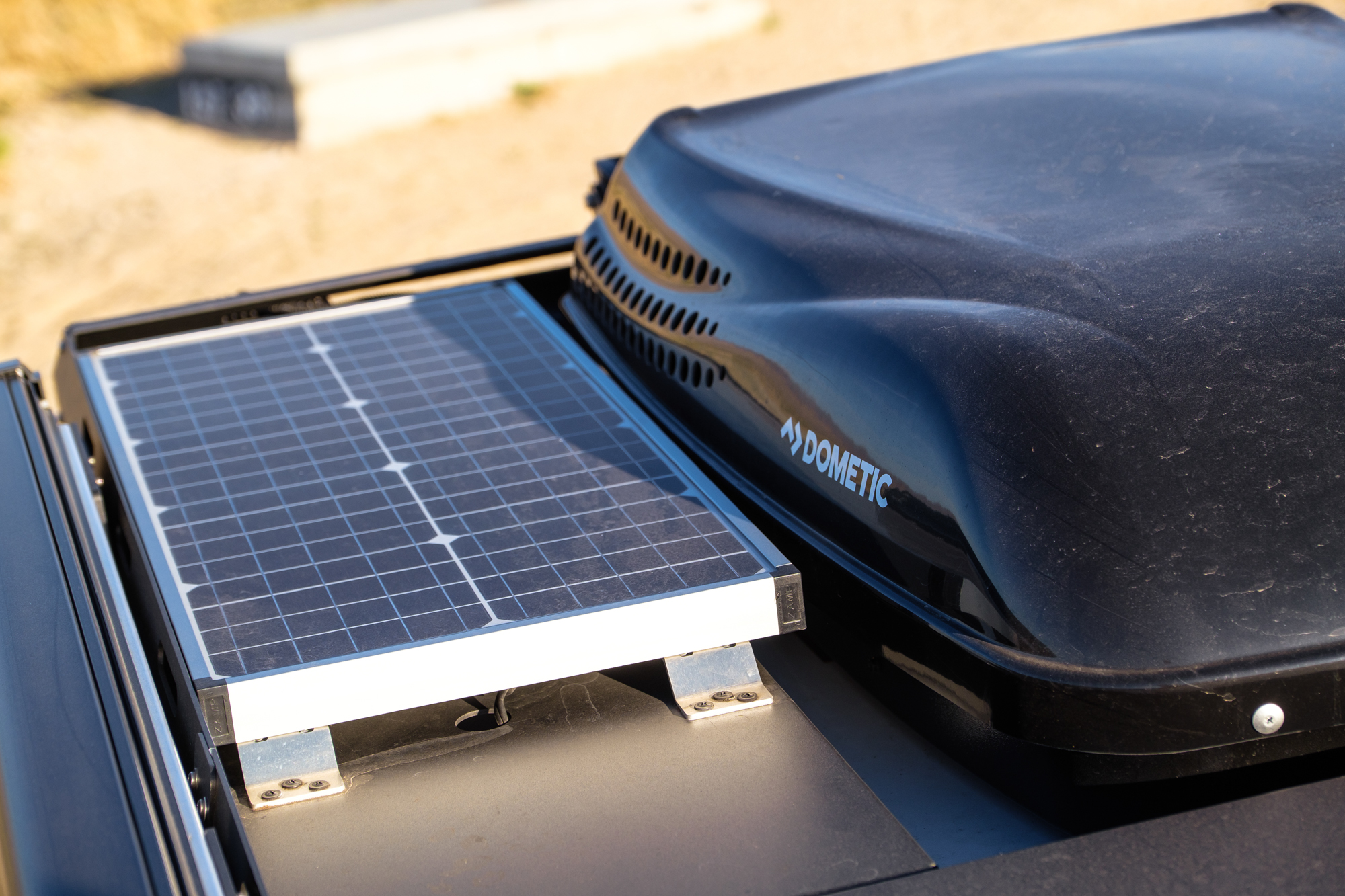

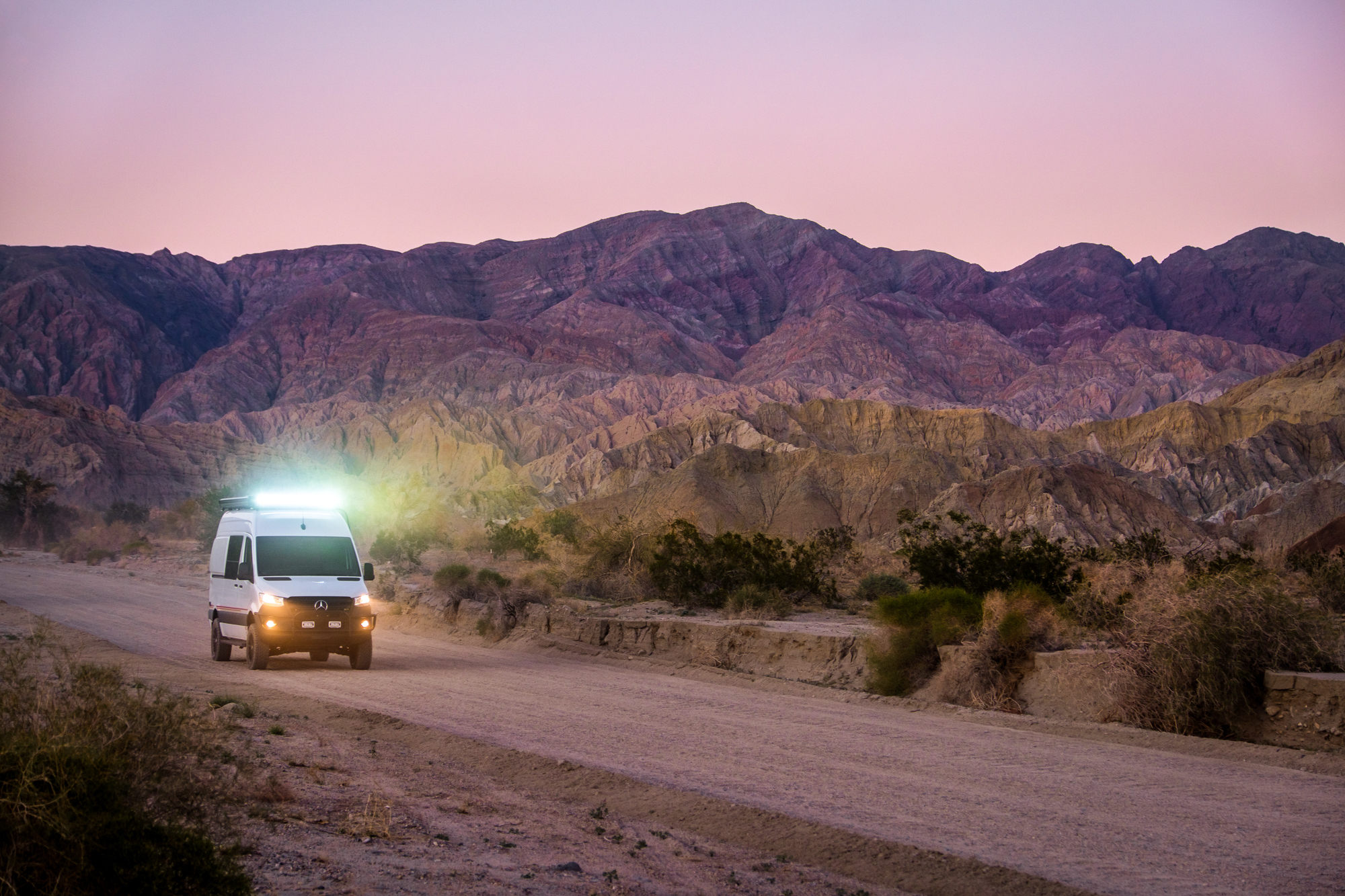
Water is supplied from a 21-gallon fresh tank stored inside the van, which prevents it from freezing and keeps it protected from rocks and obstacles on the trail. The 24-gallon gray tank, on the other hand, is below the van, but shielded with a skid plate and protected from freezing by integrated heating elements. Both the cabin and water system can be heated through the standard Rixen’s Enterprises heating system, which uses diesel fuel instead of electricity or propane. That means you only have to worry about filling up the van at the fuel station to make sure you have everything you need for a warm weekend in the woods. Oh, and don’t worry, it has a built-in cut-off to make sure it doesn’t drain your fuel tank entirely.
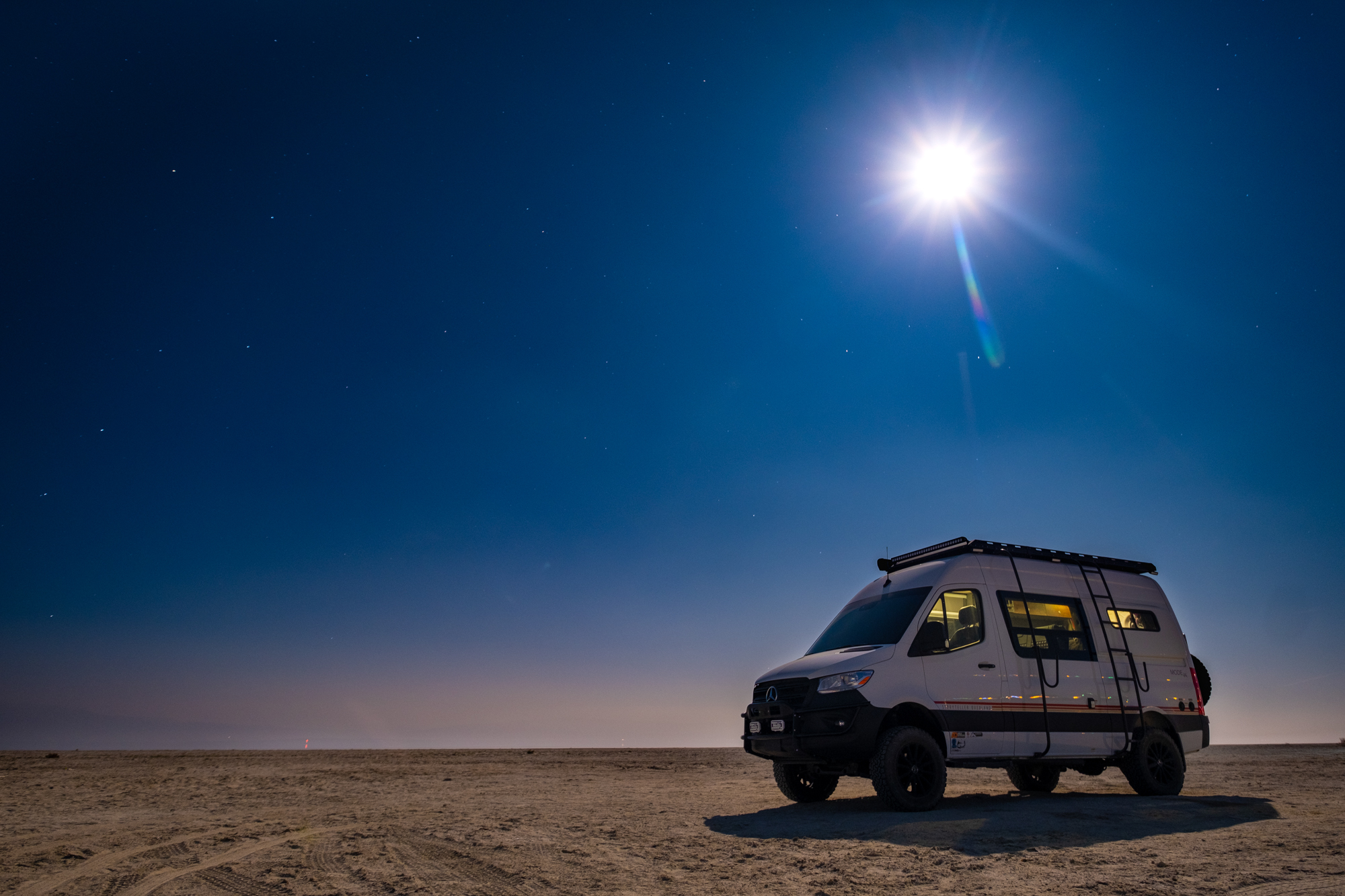
The Gear Hauler Garage
– 150-cubic-foot ruggedized garage
– Aircraft track tie-downs
– Enough room for mountain bikes
– Rinse station
– Internal water tanks avoid freezing
One of the biggest benefits to the Storyteller is the van’s flexibility in layout. It is designed to be the do-it-all adventuremobile, and thus it accommodates darn near any activity you can think of for you and up to three of your friends. One of the key components to making this happen is the 150-cubic-foot Gear Hauler. This ruggedized garage features “moon-boot flooring and walls” with aircraft track tie-downs for securing cargo of any kind. You can load up climbing equipment, skis, snowboards, backpacks, or mountain bikes. Toss in camp gear, duffel bags, or storage boxes, or slide surfboards through the passthrough into the kitchen area if needed. The Dreamweaver bed can even be folded up and out of the way for tall cargo like a dirt bike or even a paraglider. There’s under-bed lighting for visibility at night, and a rinse station to clean yourself and your gear off at the end of the day.
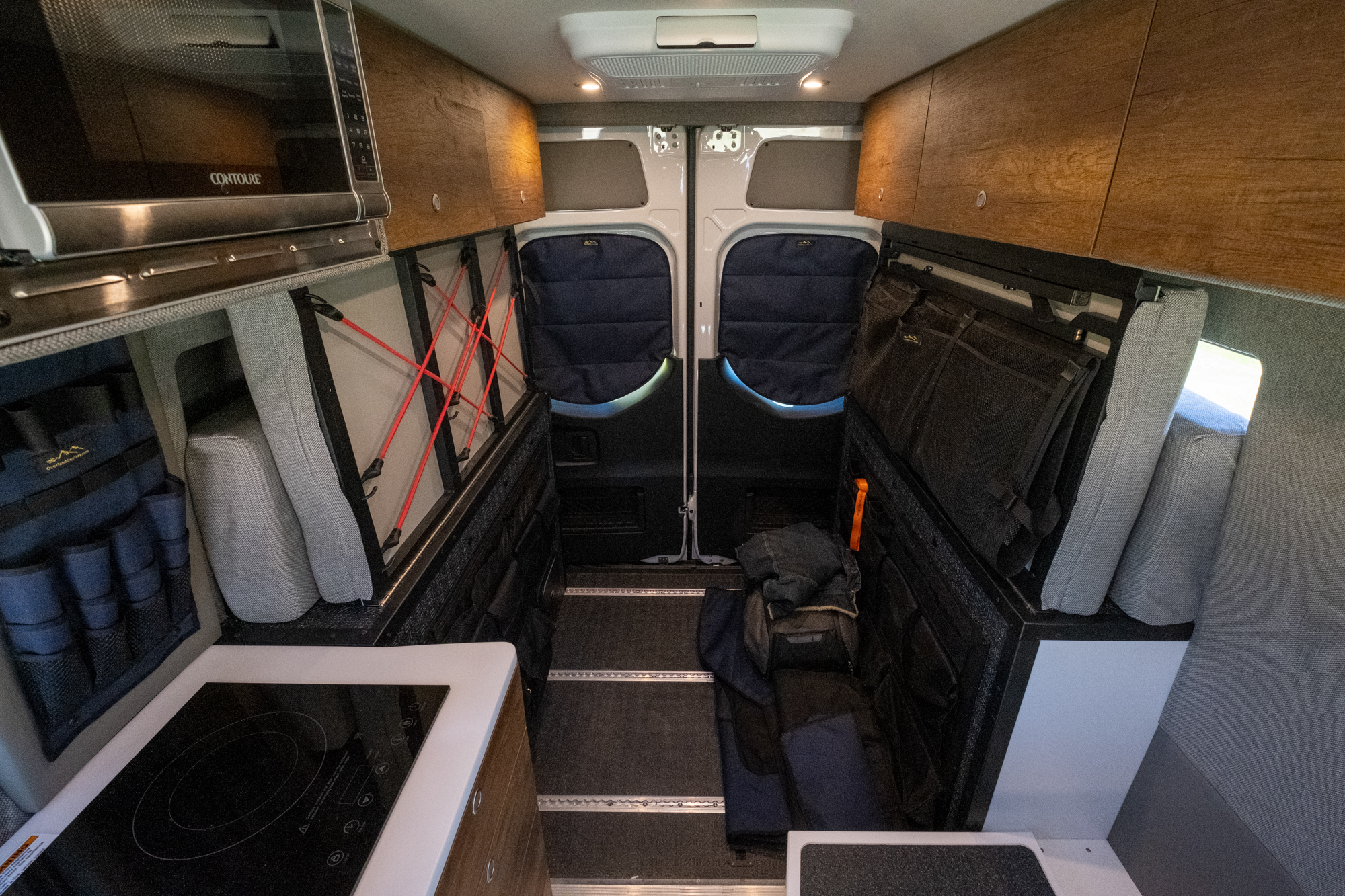
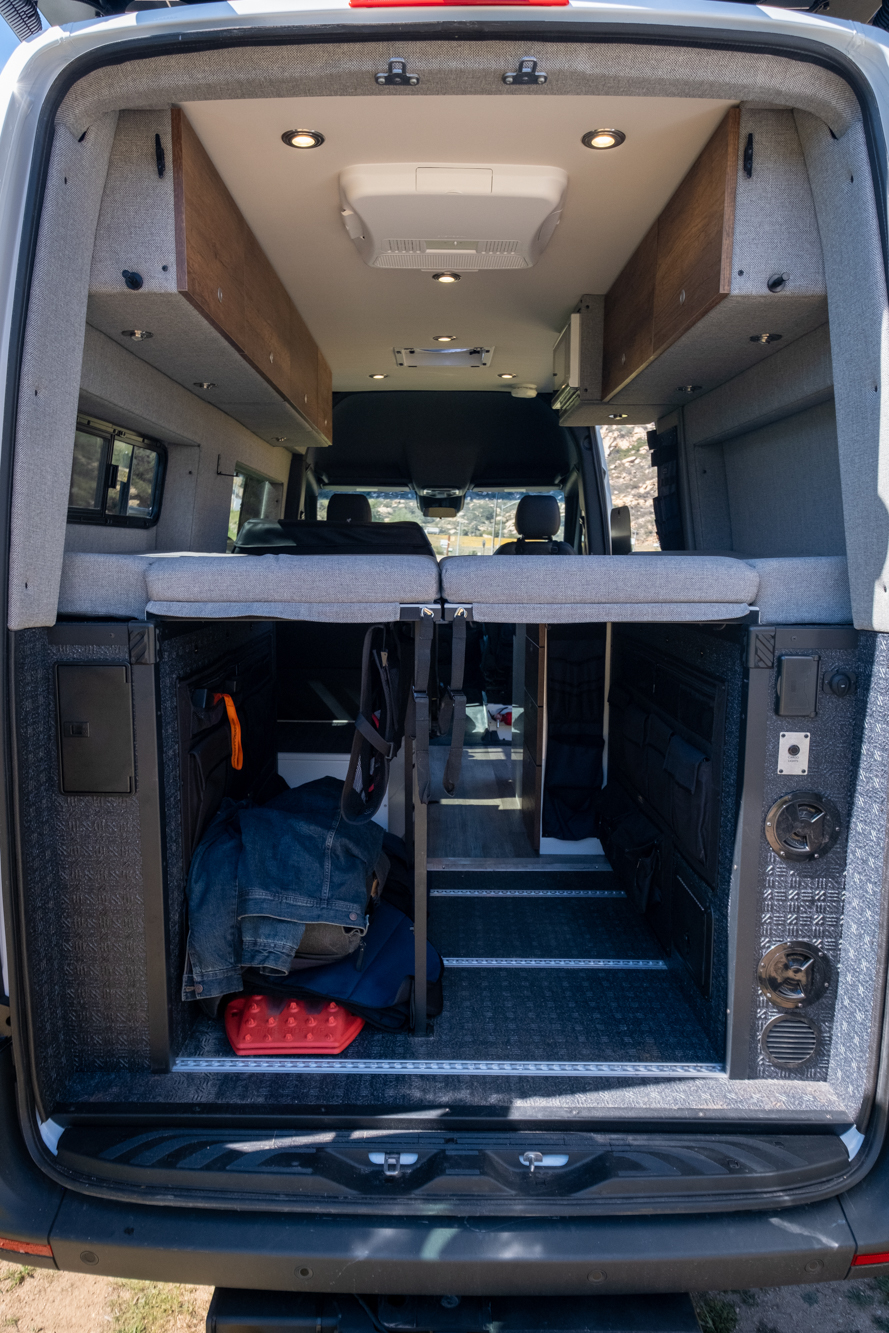
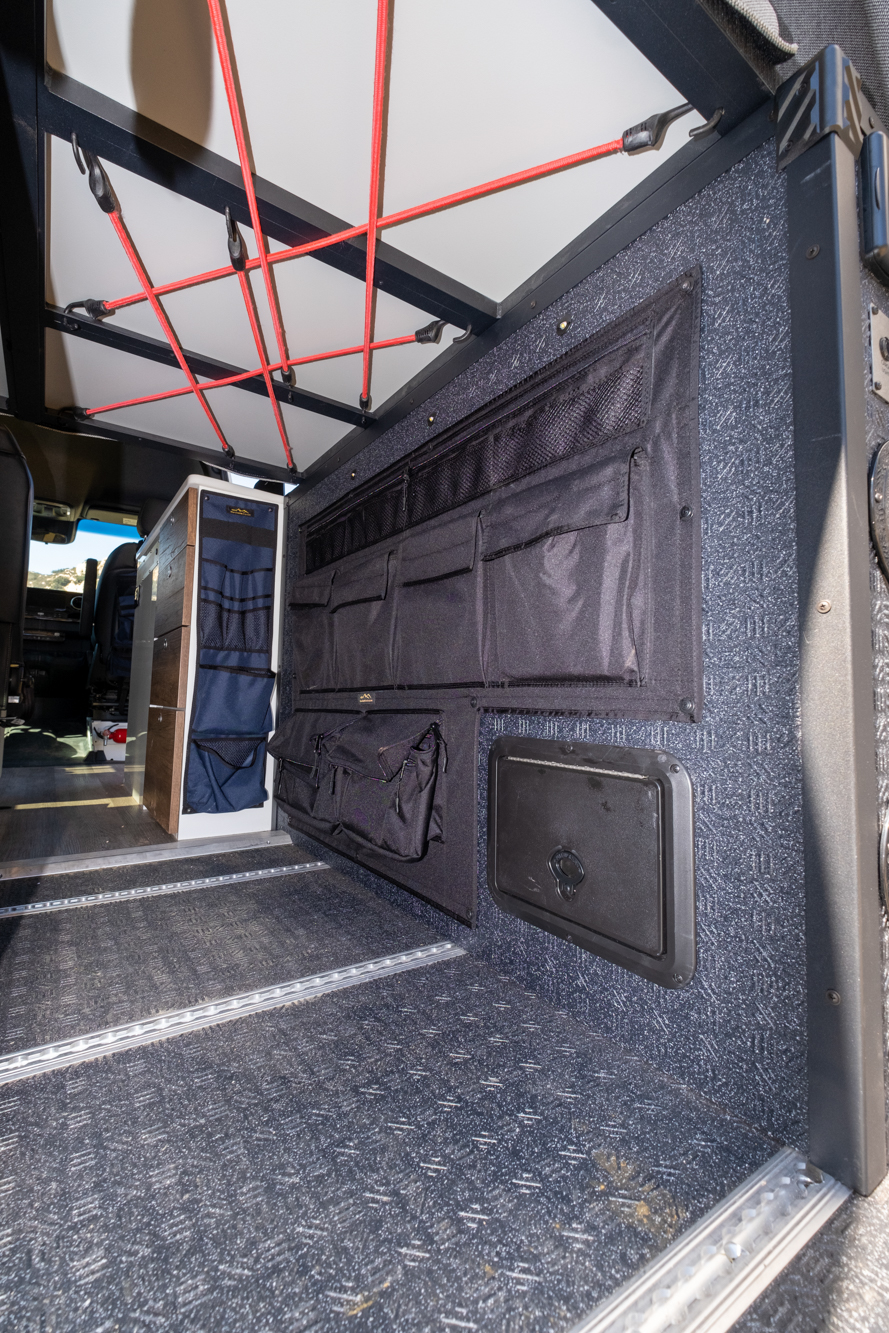
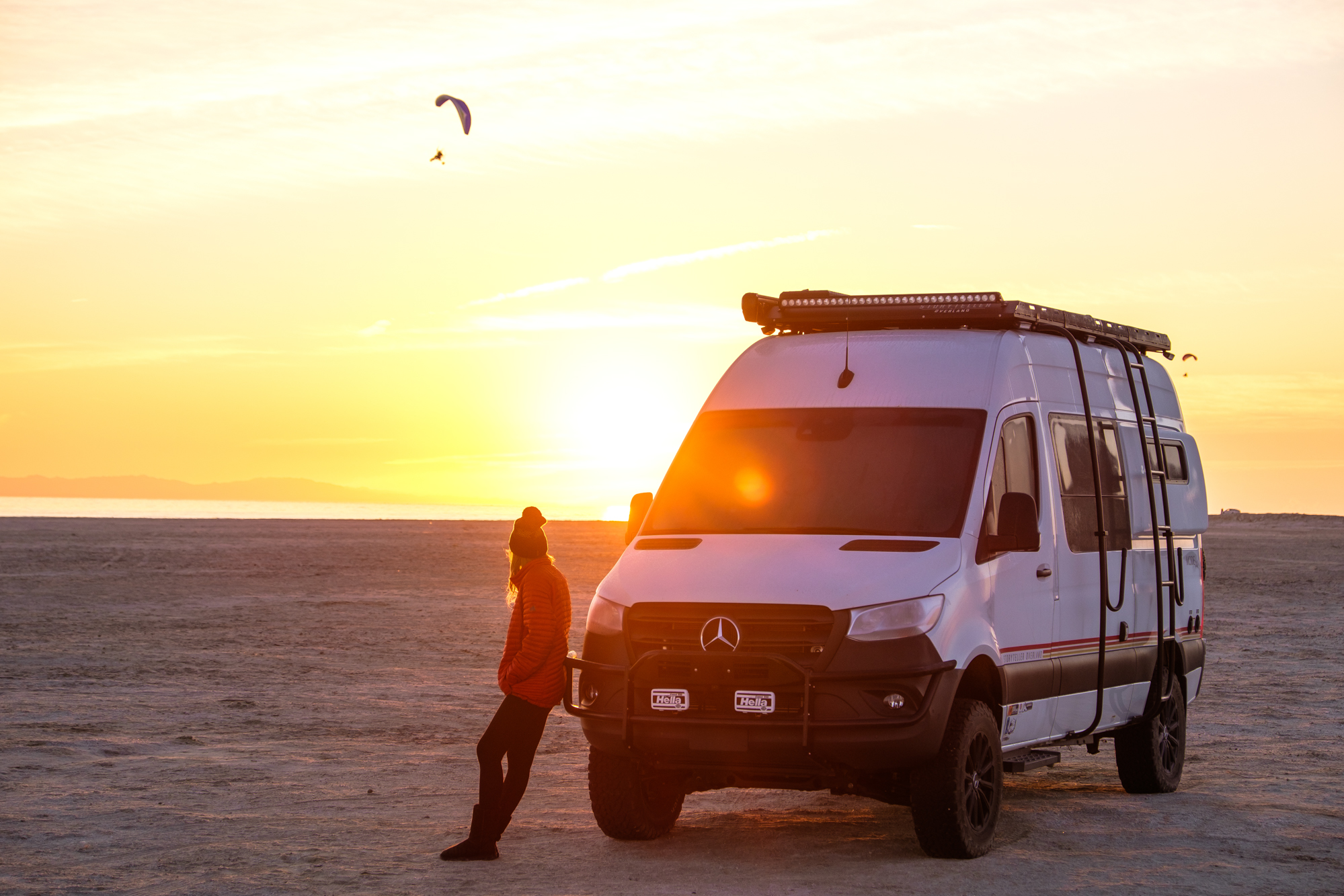
The execution of this cargo space was refreshing, to say the least, especially since most RVs lack a garage section entirely, and those who do have it often forget key details like leaving enough room beneath the bed for mountain bikes. The only downside to the Storyteller garage is that it’s not as wide as some other brands because the water tanks and electronics are stored along the outer walls. While this does take up room, it’s a compromise I will gladly take for the tradeoff of not worrying about my tanks freezing in cold weather or having them hanging off the bottom of the van.
The FlexSpace
– Halo shower gives an open feel
– Easy to use
– Results in a lack of storage space
Moving forward from the garage, you’ll find one of the Storyteller’s more unique features, their FlexSpace with Halo shower system and bathroom. Unlike other vans which lose a massive section of the interior to a shower stall, Storyteller decided to leave things open with a drop-down shower that stows in an overhead cabinet. The pan, which closes to be used as a step or seat, contains a Dometic cassette toilet when you’re not using the shower. The whole thing can be set up or collapsed in seconds, and I must admit, it’s pretty slick. I love that it leaves the midsection of the van open for a spacious feeling, but I did find it had one major compromise. Where other vans can use the walled-off shower space as a closet for gear or clothes, the Storyteller loses that storage space entirely. For people living full time on the road with a lot of clothes and gear, that could be a major drawback.
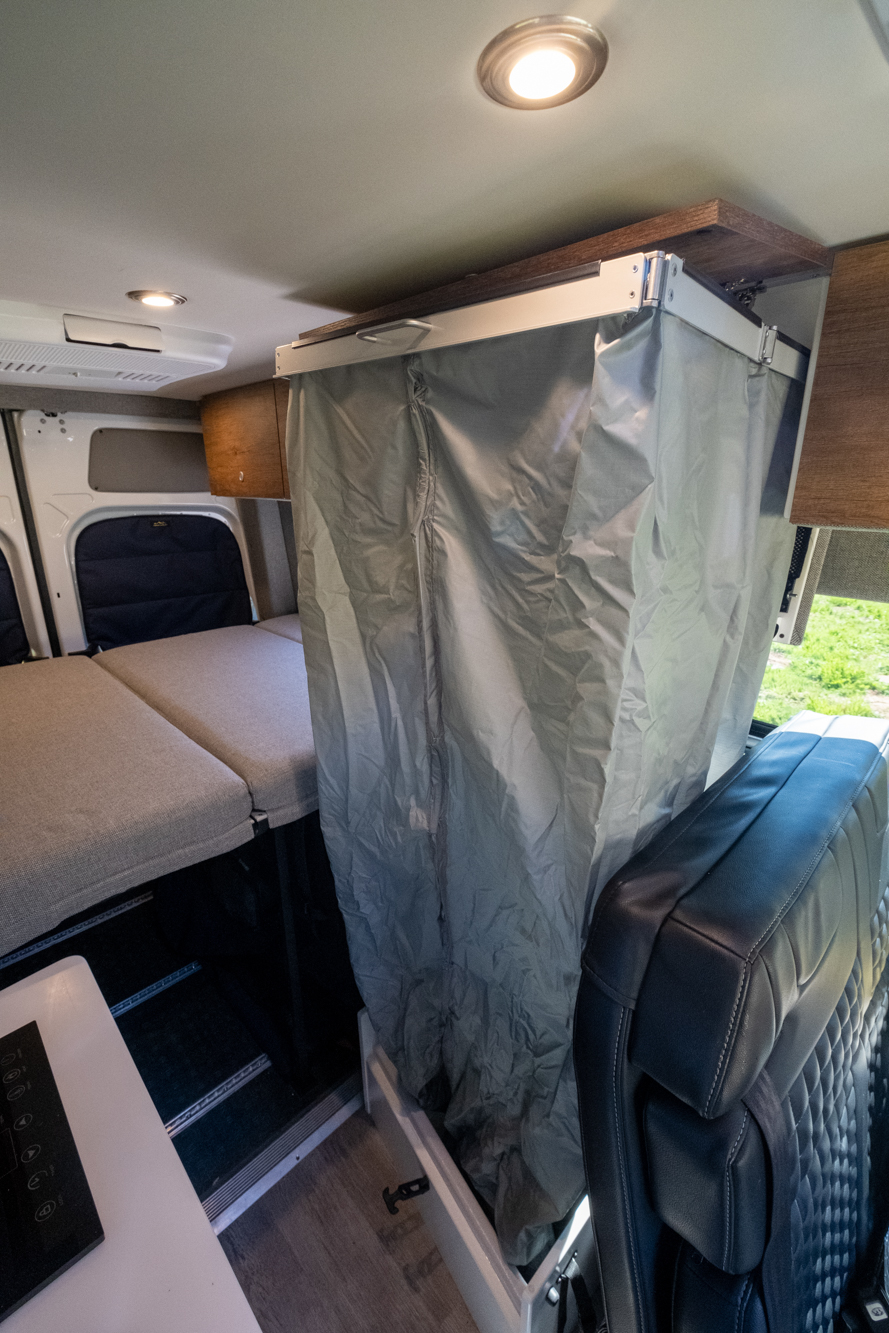

Storage Space
– FlexSpace and Groove Lounge consume a lot of space
– Leaves little room for storage outside of the garage
For full-timers, finding organized storage overall can be an issue. The van is catered more toward taking shorter trips instead of heading out full-time on the road. This isn’t to say you can’t live in one, though, just that you’d need to make some compromises or changes if that is your plan, and here’s why. Excluding the Garage, the bulk of the Mode’s storage is contained within six overhead cabinets. Four of these are located over the rear bed and are ideal for providing the driver and passenger a week to two weeks of clothes depending on how often you change. Another overhead bin is consumed by the Halo shower, which can be removed for additional storage if desired. Finally, a small overhead cabinet is located just forward of that. The remaining storage is found in three kitchen drawers which must fit all of your cutlery, utensils, plates, bowls, pots, pans, and non-refrigerated food. I can tell you that once we loaded the normal supplies from our own van, we found things were very tight, and we had to store our pans under the bed, leave the pot at home, and store our bag of tortilla chips in the microwave.
Now, if this was our own van, I am sure we would have found more creative ways to make use of the space: smaller pots and pans, an additional cabinet under the bed, perhaps a rear food cabinet on the wall beneath the halo shower. There are plenty of options, so don’t fret if you think this is a deal-breaker for the Mode, because it’s not. Just know that if you are planning to go full time on the road, you’ll want to make a few additions or buy gear to fit the van before you set out.
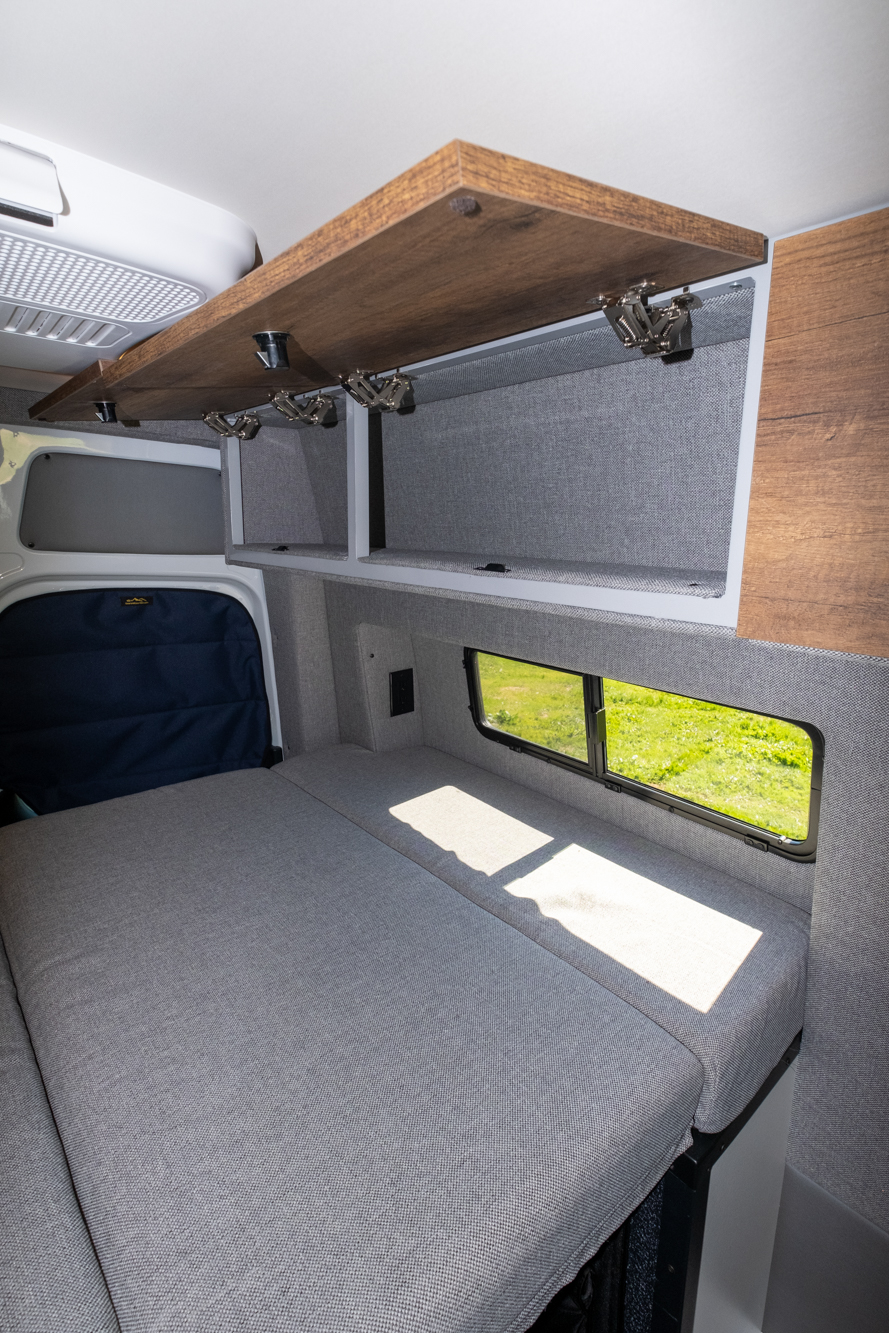
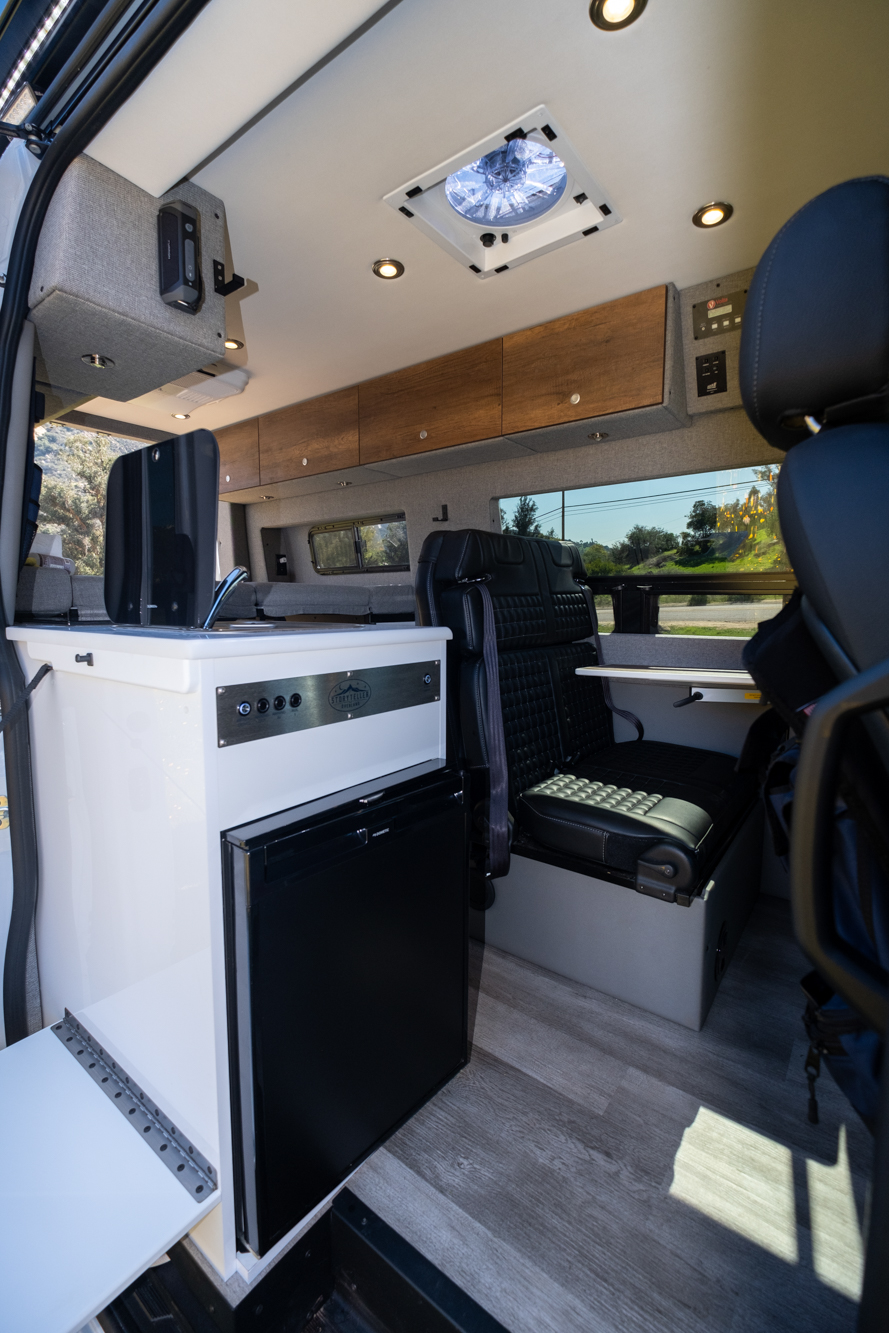
The Groove Lounge
– Safe seating for two
– Workspace, lounge space, and bed all in one
– Takes up a lot of space
The Groove Lounge is the other section of the Mode 4×4 that takes up a lot of space. If you want to carry passengers though, you can throw all of that space efficiency nonsense out the window because the Groove Lounge is a great solution. After all, who doesn’t want a groovy lounge in their van? I feel like I want to throw on a pair of bell-bottoms and an unbuttoned shirt just saying it, but there’s a lot more to love about this seat than the name. This bench features a Lagun table for working or eating and can be reclined into a lounge chair for chilling out after a long day. If you bring guests along on a trip, it can be flipped into a second bed for two kids or one adult. It’s also extremely safe. I know, safety isn’t “groovy,” but unlike many aftermarket benches that just quickly bolt in without any safety measures, this lounge has been officially tested to withstand a force of more than 15,000 pounds. You could hang two vans from this seat and it wouldn’t break off, so you can rest easy knowing your children or your friends are safe back there.
As I mentioned earlier, the only big downside to the Groove Lounge it that it consumes a lot of storage space. When combined with the FlexSpace, these two sections take up the entire driver’s side of the van from the driver seat to the garage, and that’s a big deal. Fortunately for those who want that space back, the Groove Lounge can be unbolted altogether. The base will remain in place, but a large cabinet with a countertop or something could be added instead.
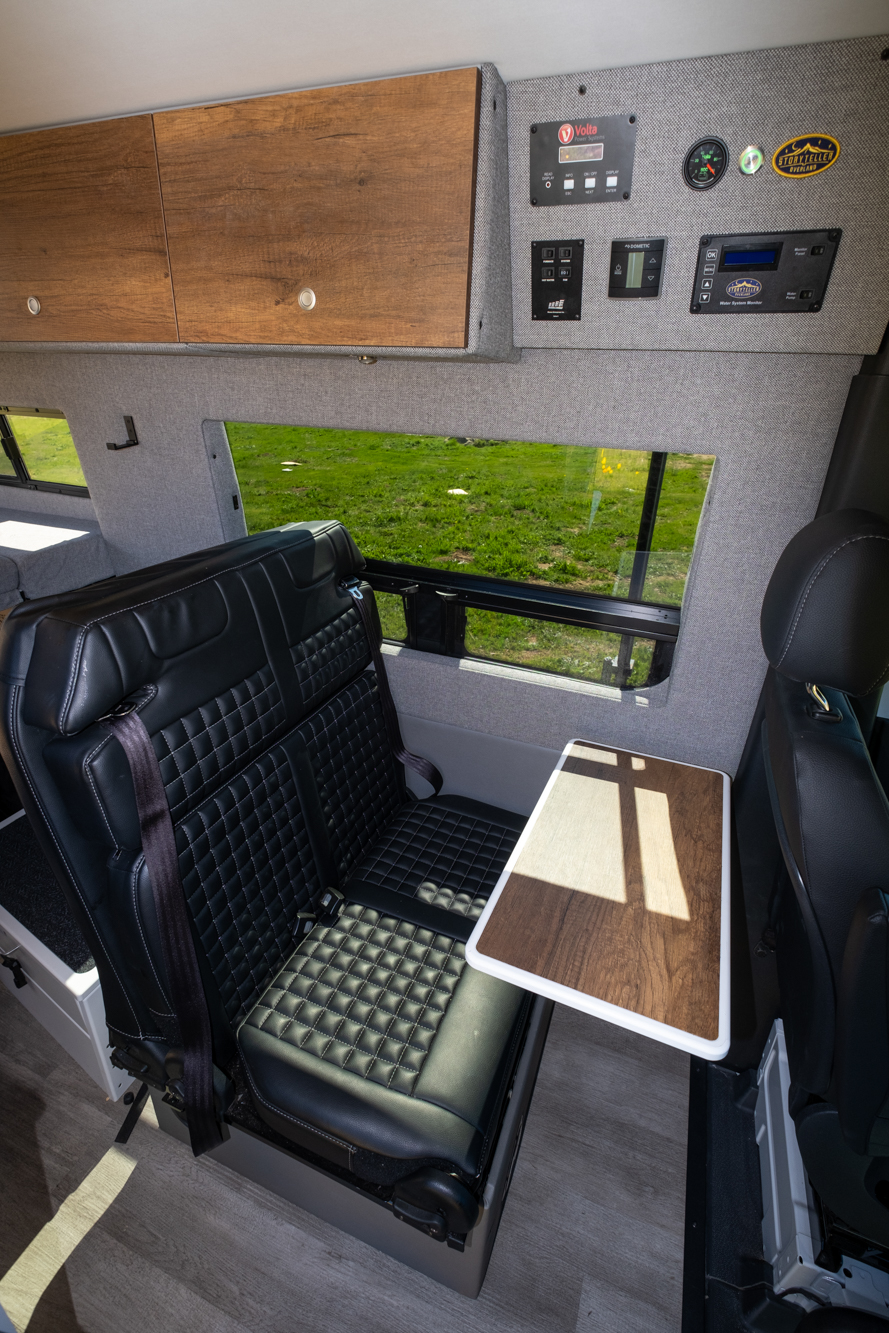
The Kitchen
– Upright Dometic fridge/freezer
– Exterior fold-down table
– Not a ton of storage
Across from the lounge, you’ll find the kitchen, which has been carefully laid out with an induction cooktop, microwave, and Dometic sink. There’s also a massive fridge for all of your perishables and drinks, and I love that it’s upright instead of the cooler style that we usually see in four-wheel drives. While there is not a load of counter space with the sink open, dropping the Dometic sink’s glass top offers additional prep space for cutting, mixing, and cleaning. There’s not an abundance of storage space, but it’s enough to get by. If I purchased this van, I would remove the microwave above the counter for non-refrigerated food, which would make a huge difference in food storage and solve the storage space issue in the kitchen entirely.
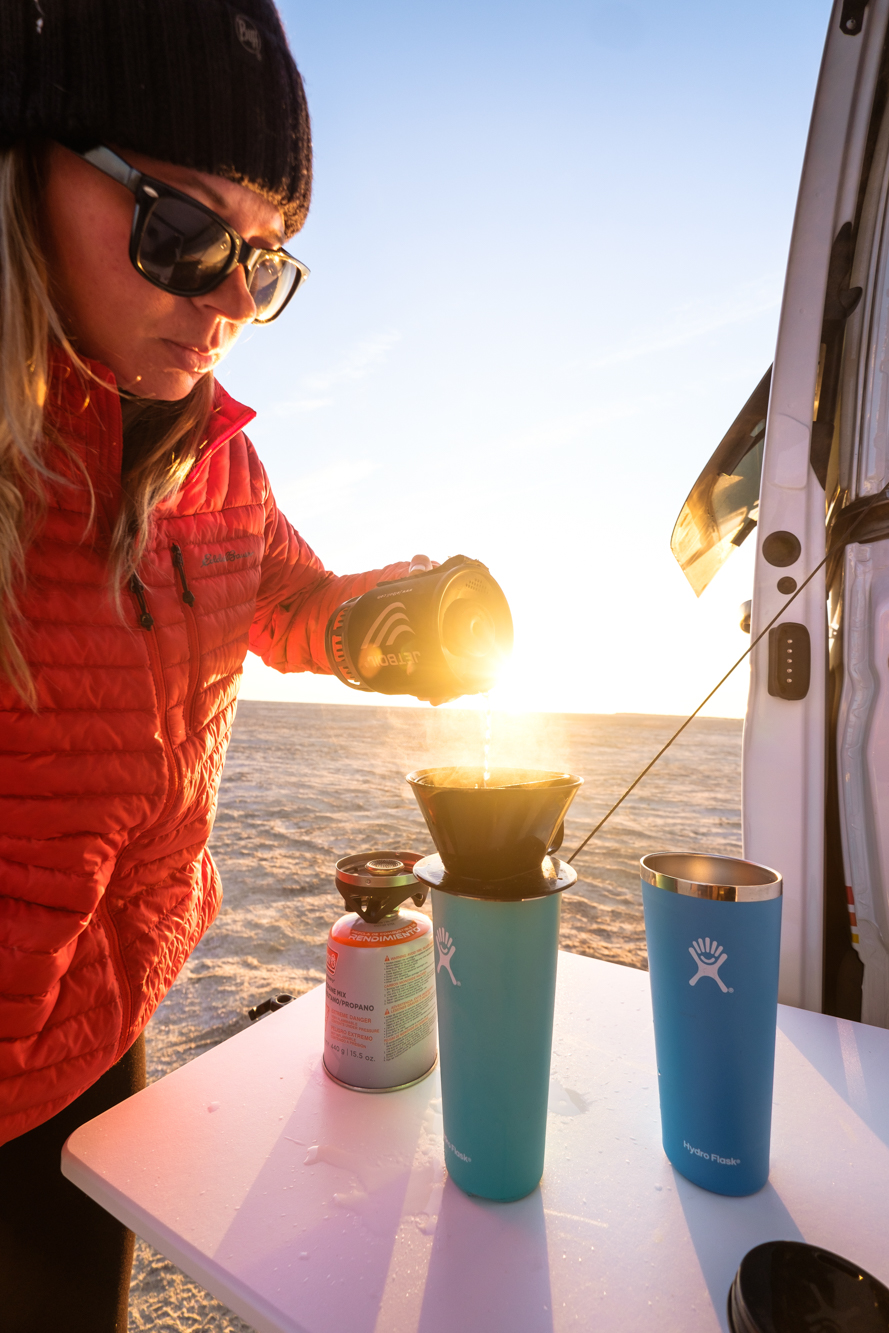
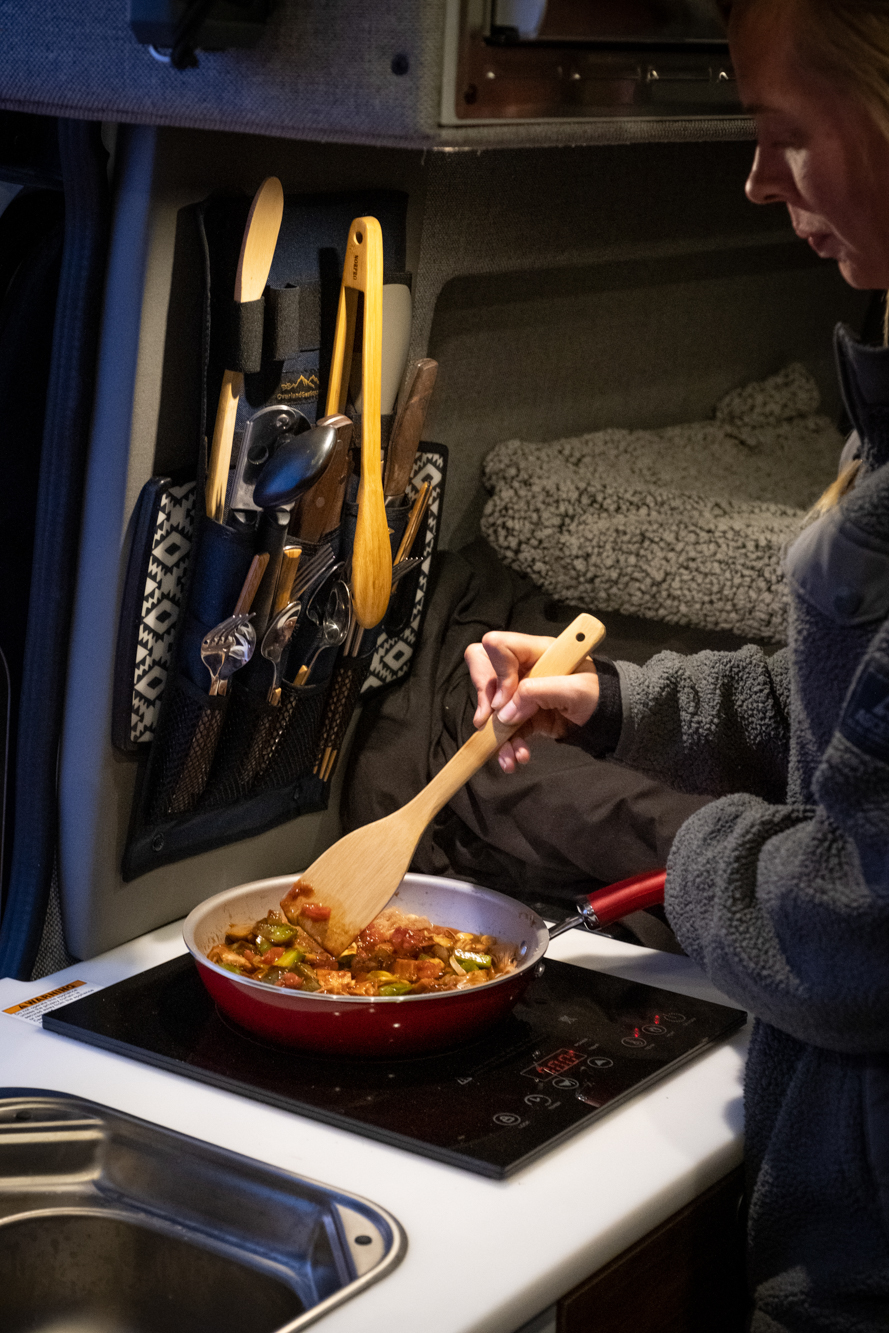

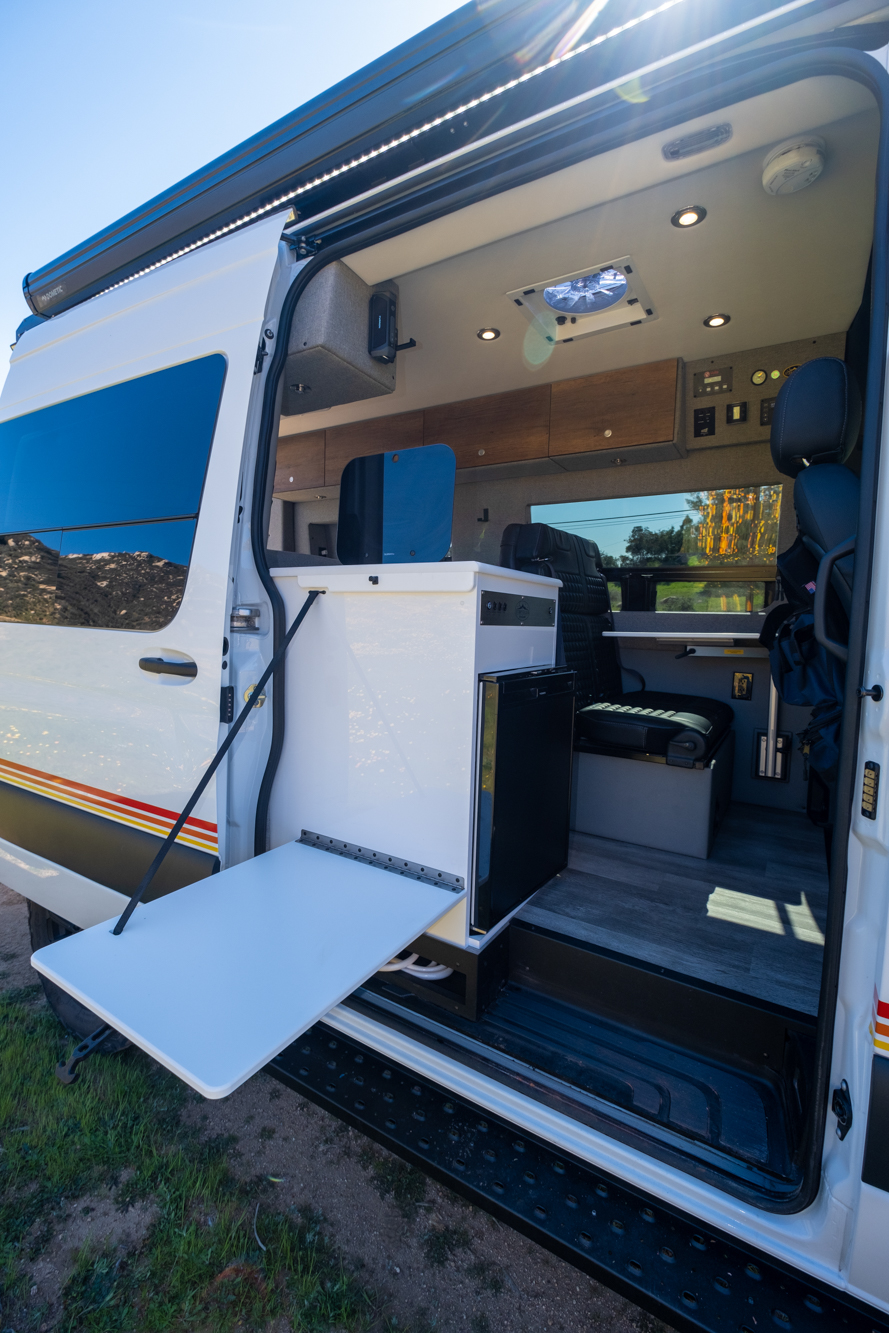
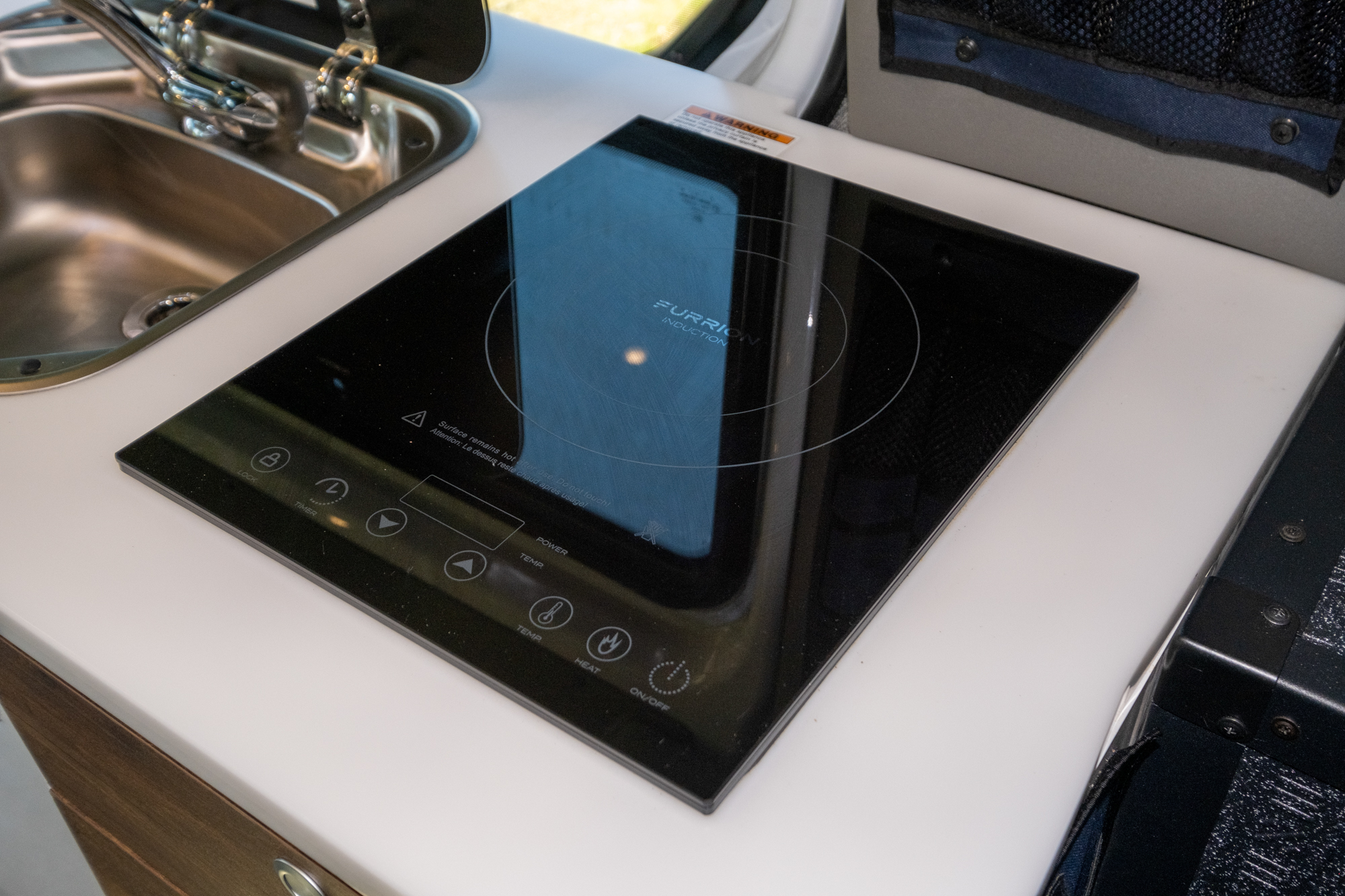
Conclusions
After spending two weeks in the Storyteller, I can say with confidence it’s not perfect, but it’s definitely one of the best out-of-the-box options on the market. It stands apart through safety, quality, and a beautiful aesthetic that won’t look like a dated RV in 10 years’ time. If you’re looking for an adventure rig to take on weekend to month-long trips, the Storyteller is your ideal van. If you’re looking to go full time on the road, it may need a few changes to add storage, but it’s still one heck of a good place to start. For more information: storytelleroverland.com | 888-999-7442
